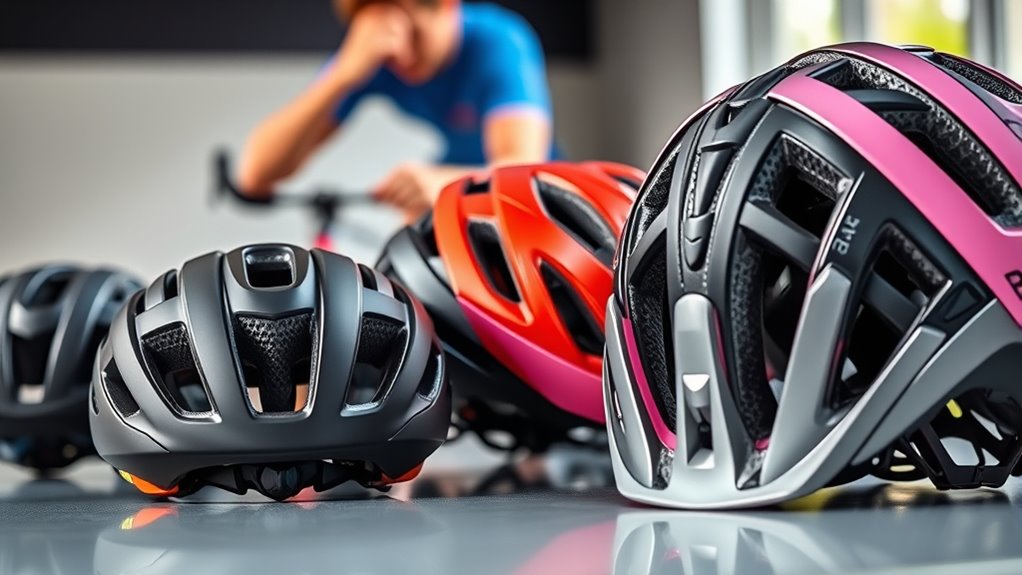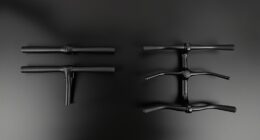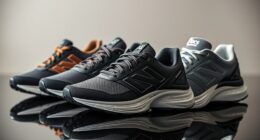Choosing the right bike helmet means finding one that fits snugly without feeling tight, with straps sitting comfortably against your chin. Make sure it meets safety standards to protect you in any fall and consider your riding style, climate, and personal style preferences. Ventilation keeps you cool, and bold colors boost visibility. Finding a helmet that combines safety, comfort, and style helps you ride confidently. Keep exploring to discover more tips for choosing the perfect helmet for you.
Key Takeaways
- Measure your head accurately and choose a helmet that fits snugly without wobbling for optimal safety and comfort.
- Ensure the helmet meets regional safety standards (e.g., CPSC, EN 1078) for reliable protection.
- Select a style and shape that complements your face and matches your riding activity, boosting confidence and style.
- Prioritize ventilation features for hot weather or climate-appropriate design to stay cool and comfortable.
- Opt for lightweight, visible helmets with reflective elements that suit your personal style and enhance safety.

Are you wondering how to choose the right bike helmet for your needs? Picking the perfect helmet isn’t just about safety; it’s also about comfort and style. When you start shopping, keep in mind that a helmet should fit snugly without feeling too tight. It shouldn’t wobble when you shake your head or leave painful pressure points. To find the best fit, measure your head circumference with a soft tape measure, usually just above your eyebrows and around the widest part of your head. Most helmets come in various sizes, so use these measurements to guide your choice. Remember, a helmet that’s too loose can slip off during a fall, while one that’s too tight can cause headaches and discomfort. Adjust the straps so they sit flat against your chin and cheeks, and ensure you can comfortably open and close your mouth. Additionally, consider the helmet’s certification standards to ensure it meets safety requirements in your region. Beyond fit, consider the helmet’s shape and design. There are different styles tailored for various cycling activities, such as road biking, mountain biking, or commuting. Look for a helmet that matches your riding style, but also one that complements your head shape. Some helmets have more elongated shells, while others are rounder, so try on several to see which feels best. Ventilation is another vital factor. If you ride in hot weather, choose a helmet with ample vents that allow air to circulate, helping you stay cool and sweat less. On the other hand, if you bike in cooler climates, you might prefer a helmet with fewer vents or additional lining for warmth. A flattering helmet is one that complements your face shape and personal style. Don’t shy away from bold colors or sleek designs if they boost your confidence. When a helmet looks good, you’re more likely to wear it consistently, which is the most important thing for safety. Reflective elements or bright colors can also improve visibility, making you safer on the road or trail. Proper fit is essential to maximize protection and comfort during your rides. Finding a helmet that also meets your safety standards is crucial to ensure it provides reliable protection in case of an accident. Remember that helmet weight can influence comfort, especially during longer rides, so choose a lightweight option if you plan to ride for extended periods. Guarantee your helmet meets safety standards relevant to your region. Look for certifications such as CPSC, ASTM, or EN 1078, which verify the helmet has passed rigorous safety tests. While style and comfort matter, safety should always come first. When you find a helmet that fits well, feels good, looks great, and meets safety standards, you’re not just protecting your head—you’re also making a style statement. Take your time trying different options until you find one that checks all the boxes, so every ride feels safe and enjoyable.
Frequently Asked Questions
How Often Should I Replace My Bike Helmet?
You should substitute your bike helmet every 5 to 10 years, or sooner if it’s been involved in a crash. Even if it looks fine, the materials can weaken over time, reducing protection. Regularly check for cracks, dents, or frayed straps. If you notice any damage, replace your helmet immediately. Wearing a well-maintained helmet ensures you stay safe and protected during every ride.
Are There Helmets Designed Specifically for Women or Children?
You’ll find helmets designed specifically for women and children, offering tailored fits and styles. Women’s helmets often have narrower profiles and more aesthetic options, while children’s helmets are lightweight and adjustable for growing heads. These designs prioritize comfort, safety, and style, so you can choose one that fits well and makes you feel confident. Always guarantee the helmet meets safety standards regardless of its design or target demographic.
Can I Wear Sunglasses With My Helmet?
Yes, you can wear sunglasses with your helmet. Just make sure they fit comfortably and don’t interfere with the helmet’s fit or safety. Opt for sunglasses with a secure fit, like wraparound styles, to keep them in place while you ride. Adjust the helmet straps so they sit properly, and try on your sunglasses during helmet fitting to ensure everything feels comfortable and secure for your ride.
What Safety Standards Should My Helmet Meet?
When choosing a helmet, you should check that it meets safety standards like CPSC, ASTM, or CE. These certifications guarantee your helmet has passed rigorous impact tests. Look for labels inside the helmet indicating compliance. Don’t compromise on safety—make sure your helmet is certified, fits well, and provides proper coverage. This way, you can ride confidently, knowing you’re protected if an accident occurs.
Do Lightweight Helmets Offer the Same Protection as Heavier Ones?
You might wonder if lightweight helmets offer the same protection as heavier ones. Generally, modern lightweight helmets are designed with advanced materials that meet strict safety standards, ensuring they provide comparable protection. As long as the helmet meets certifications like CPSC, ASTM, or EN1078, you can trust its safety. Remember, fit and proper adjustment are essential for maximum protection, regardless of weight.
Conclusion
Remember, a helmet that fits well and makes you feel good boosts your confidence on every ride. Don’t settle for just any helmet—find one that suits your style and keeps you safe. As they say, “Better safe than sorry,” so prioritize comfort and fit above all. When you choose the right helmet, you’re not just protecting your head—you’re also pedaling with peace of mind. Happy riding!









